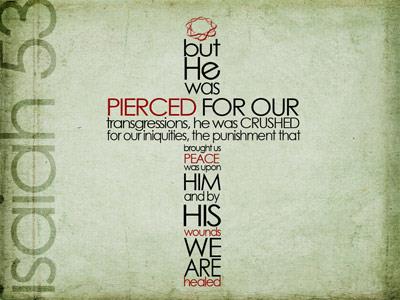-
Symbols Of Semblance Series
Contributed by Ajai Prakash on Nov 28, 2017 (message contributor)
Summary: Our will and God’s will are as two separate pieces of wood; so long as both lie side by side there is no cross; but put them across one another, and then there is a cross. We must take up the cross Christ lays on us if we would be His disciples. Whenever
Illustration: The deepest demonstration of love is to willingly sacrifice oneself for the benefit of another. There is a story about Pat Thorne who was a sniper atop a tree, saw a platoon of Canadian soldiers walking on a road in the direction of a German contingent. Wanting to warn them and knowing he couldn’t possibly take out the whole German platoon, he fired warning shots in the direction of the enemy. He didn’t expect them to actually turn in the direction of the shot and fire aimlessly toward him. He remembers getting hit, feeling warm, falling, and waking up in an American hospital. His medal for that act of bravery is paralysis and a wheelchair for over 50 years of his life and not being able to lie in a bed, being propped upright in a chair where he sleeps at night.
Stories like these move us deeply. It leads us however to reach for an even higher meaning if we will grasp the greatest principle intended in this passage of laying down one’s life, for doing so does not always mean death. It is that experience of embracing a LIFESTYLE that is always about everyone else. The level of our “intimate and organic” relationship with God determines the extent that we embrace the LIFESTYLE of living for others.
In today’s context of passages we will see the lifestyle of Christ in the imagery of the final symbols of passion. Because of their nature of similarity, we call them the ‘Symbols of Semblance.’
One by one, let us look into the symbols of mockery, suffering and sin-
1. Crown of Thorns [symbol of mockery] Matthew 27: 27 – 31:
Our Lord was crowned with thorns, in mockery, by the Roman soldiers. Obviously, some small flexile thorny shrub is meant perhaps Capparis spinosa. "Hasselquist, a Swedish naturalist, supposes a very common plant naba or nubka of the Arabs, with many small and sharp spines; soft, round and pliant branches; leaves much resembling ivy, of a very deep green, as if, in designed mockery, of a victor’s wreath." - Alford.
They wove a crown out of thorns which would grow even in the palace grounds. It is immaterial whether they were young and tender thorn bushes, as probable in the spring, or hard bushes with sharp prongs. The soldiers would not care, for they were after ridicule and mockery even if it caused pain. It was more like a victor’s garland than a royal diadem, but it served the purpose. So with the reed, a stalk of common cane grass which served as scepter.
Had platted - The word “platted” here means “woven together.” They made a “wreath” of a thorn-bush.
A crown - Or perhaps, rather, a wreath made of thorns. A crown was worn by kings, commonly made of gold and precious stones. To ridicule the pretensions of Jesus that he was a king, they probably plucked up a thorn bush growing near, made it into something resembling in shape a royal crown, so as to correspond with the old purple robe, and to complete the mockery.
Of thorns - What was the precise species of shrub denoted here is not certainly known. It was, however, doubtless, one of that species that has sharp points of very hard wood. They could therefore be easily pressed into the slain and cause considerable pain. Probably they seized upon the first thing in their way that could be made into a crown, and this happened to be a “thorn,” thus increasing the sufferings of the Redeemer. Palestine abounds with thorny shrubs and plants. “The traveler finds them in his path, go where he may. Many of them are small, but some grow as high as a man’s head. The Rabbinical writers say that there are no less than 22 words in the Hebrew Bible denoting thorny and prickly plants.”
Purpose of the crown of thorns:
• Ridicule
• Mockery (Scorn)
• Torture
Application: Whenever we are treated with ridicule, scorn or torture for Christ sake, how do we react?
(a) God has made me great, so you can’t treat me like this ………
(b) You just can’t treat me like a doormat. In today’s context, it is being abusive…….
(c) Take it all, just the way Christ did.
Illustration: All over the middle-east even till today you can see the evidence of the thorny vines which were used for a crown on the head of Christ. The pricks of these thorns could make one numb and render endless and unbearable pain. Sitting here comfortably we may not even comprehend such things. The physical pain was evident but there was a greater pain for the Father for sacrificing His Son and the pain of the Son being rejected by His Father for us all that tore Christ apart so that we might have eternal life.

 Sermon Central
Sermon Central



